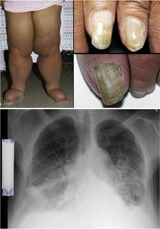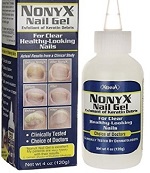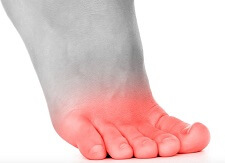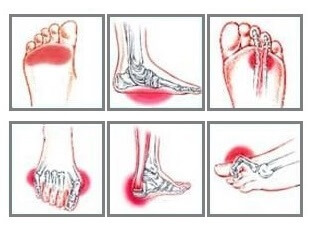- Home
- Foot Pain Symptoms
- Yellow Toenails
Yellow Toenails
Written By: Chloe Wilson BSc(Hons) Physiotherapy
Reviewed By: FPE Medical Review Board
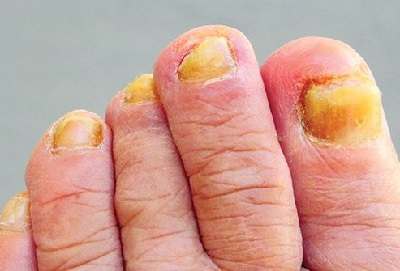
Yellow toenails are a common problem with a variety of possible causes. Changes in toenail colour usually develop gradually over time.
Yellow toe nails may also be associated with hardening and thickening of the nail, which may also become brittle and prone to breakage.
Yellow toenails may be from something simple such as nail polish, a fungal infection or in some cases may be a sign of a serious underlying medical condition which requires attention. But how can you tell the difference?
Why Are My Nails Yellow?
There are a number of different things that can cause yellow toenails. Let's have a look at the most common causes of yellow toe nails, what causes them and what other symptoms may be associated with them to help you work out what is going on and what you can do to treat them.
1. Fungal Nail Infections
The most common cause of yellow toenails is a fungal infection that attacks the nail, known as onychomycosis. It is often ignored initially as there is little if any discomfort, but the longer it is left untreated, the longer it will take to clear when treatment does finally begin.
Fungal infections tend to be located underneath the nail. It may start with a yellow spot under the nail that gradually spreads through the nail, and some people even develop yellow skin around their nails. Fungal nail infections gradually eat away at the keratin, the protein that makes nails hard and strong. Fungal toenail infections can also be linked with yeast infections elsewhere in the body or may spread from athlete's foot.
The type of infection tends to vary depending on the climate you live in – in cool, temperate climates yellow nail fungus is typically due to dermatophytes, whereas in hot, humid, tropical environments it tends to be from non-dermatophylic moulds or candida.
Symptoms Of Yellow Nail Fungus
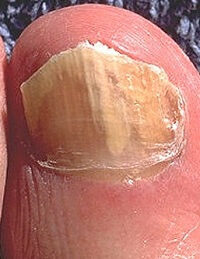
In most cases, the first sign of a fungal nail infection is the gradual discoloration of the toenails starting at the edge of the nail and spreading inwards. Eventually, the whole nail turns yellow.
The nails gradually thicken, become brittle and may even break and in some instances there may be a foul smell from the infection.
There may also be some pain or discomfort when pressure is placed on the nails or when wearing shoes. Typically it is the big and little toes that are most affected by fungal nail infections and you often end up with thick nails.
Causes of Fungal Yellow Toenails
Common causes of yellow toenails from fungal nail infections include:
- Footwear: tight, ill-fitting shoes and socks that don’t let your feet breathe or place repetitive pressure on the toes
- Sweating: excessive sweating increases moisture
- Environment: living or working in a humid or damp environment
- Skin Conditions: such as psoriasis
- Medical Conditions: such as diabetes or peripheral vascular disease
- Injury: damage to the nail or surrounding skin
- Age: increased risk with aging
Fungus thrives in moist, warm, damp conditions so fungal toenail infections are often picked up from walking barefoot in public places such as swimming pools, public showers and gyms.
Yellow toenails from fungal infections are fairly common with approximately 10% of the adult population suffering from onychomycosis at some point in their lives.
2. Yellow Nail Syndrome
Yellow Nail Syndrome is a rare, but serious cause of yellow toenails. There are three typical characteristics with this yellow nail syndrome:
- Yellow Nails: Nails are slow to grow, thickened and discoloured a yellow/green colour. There may be ridges across the nails as well as increased curvature and in some cases the nail detaches from the nail bed
- Lymphedema: Swelling of the limbs due to fluid retention, which most commonly affects both legs but in some cases may also affect the arms and face. About 80% of people with yellow nail syndrome will develop lymphedema, and in around one third of cases it is the first sign of the condition
- Lung Problems: Many people with yellow nail syndrome will experience respiratory problems such shortness of breath and coughing. Around a half of those with yellow nail syndrome will suffer from recurrent chest infections or bronchiectasis, a chronic lung condition where the airways become damaged and excess mucus is produced. Pleural effusions (excess fluid in the space surrounding the lungs) affect around 40% of people with yellow nail syndrome
People who present with at least two of these three symptoms are usually diagnosed with yellow nail syndrome. Yellow toenails and/or fingernails are usually always seen in this condition but the colour changes may be quite subtle. Treatment for yellow nail syndrome usually focuses on addressing any lymphedema or respiratory issues. Vitamin E may be given to help reduce nail discoloration.
If you suspect you may have yellow nail syndrome, you should seek prompt medical advice.
3. Nail Polish Stains
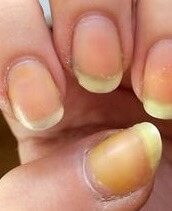
Another common cause of yellow nails is staining from nail polish. Many brands of nail polish contain iron oxide which over time can absorb into the nail resulting in yellow toenails.
Repetitive painting of your nails can lead to discoloration. This is particularly common when using red, orange or darker shades of nail polish.
Frequent use of nail polish can also trap moisture under the nail bed which may lead to infection and therefore nail discoloration. You may notice yellow skin around your nails.
The simplest way to treat discolouration caused by nail polish is to leave the nails un-painted for a couple of weeks and they should return to their normal colour. When you do then want to repaint them, always apply a base coat and avoid reds and oranges, opting instead for lighter colours.
Applying a clear base coat before applying polish can help reduce staining and the risk of developing yellow toe nails.
4. Jaundice
Yellowing of the skin is the classic feature of jaundice but yellow toenails are often seen with it as well. Jaundice is a medical condition where a problem with the liver causes high levels of bilirubin, resulting in yellowing of the skin, eyes, mouth and nails.
It would be extremely unusual for the only symptom of jaundice to be yellow toenails, so if you have no other symptoms, you are unlikely to be suffering from jaundice. However, if you have noticed a yellow/green tinge to your skin or in the white your eyes, or have noticed your urine is darker or your faeces lighter than usual, you should consult your doctor.
Other Causes of Yellow Toenails
Other possible, less common, causes of yellow toenails include:
1. Psoriasis
Psoriasis is a chronic autoimmune disease causing patches of red, flaky skin covered with silver coloured scales. It is sometime associated with nail discolouration, typically yellow, brown or green and it may look like there is a drop of oil underneath the nail. Find out more about nail psoriasis and how to treat it.
2. Paronychia
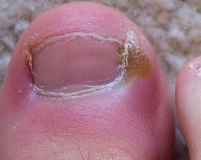
This is a bacterial infection in the nail or surrounding skin that results in redness, inflammation and pus around the edge of the nail, and thickening and discoloration of the nails. It may affect the fingernails or toenails with the nails turning yellow over time.
3. Diabetes
Type 2 diabetes is often accompanied by poor circulation and nerve damage in the feet which can lead to yellowing or blackening of the toenails. Good foot care is vital for anyone suffering from diabetes, so if you have developed yellow toenails and are diabetic, consult your doctor promptly.
4. Aging
As we age, our nail structure changes and becomes more brittle, making them more prone to yellowing. It is therefore common for older people to have thick nails which often turn a yellowish colour.
5. Poor Hygeine
Poor nail hygiene, such as not washing your hands regularly or failing to trim your nails, can lead to a buildup of dirt and bacteria, which can cause the nails to turn yellow.
6. Certain Medications
Some medications, such as chemotherapy drugs, can cause yellowing of the nails as a side effect.
7. Smoking
Nicotine and other chemicals in cigarettes can stain nails, leaving them yellowish. The occasional cigarette is unlikely to turn your nails yellow, but if you smoke regularly you may notice a gradually darkening tinge of yellow on your nails.
How To Treat Yellow Nails
There are a few ways to treat yellow nails, such as trimming and filing your nails, using an anti-fungal cream or solution, and practicing good hygiene. Additionally, it is important to avoid further damaging your nails, as this can lead to further discoloration.
Yellow toenails may last anything from a few days to several months, depending on the underlying cause. For simple things such as nail varnish staining, it usually take s a couple of weeks for the nails to return to their normal color, but with fungal infections, yellow nails may take months to fully recover.
Treatment For Yellow Nail Fungus
Treatment for nail fungus should be started as promptly as possible, so don’t ignore yellow toenails hoping they will just sort themselves out. Treatment for yellow nail fungus usually involves using one or more of the following:
- Topical Treatment: usually in the form of a gel or polish that you apply directly to yellow toenails twice a day until the infection has cleared completely – this can take six to twelve months
- Oral Antifungal Medication: such as Lamisil. This tends to be more effective than the polish, but may not be appropriate if you have other health conditions
- Toenail Removal: this may be done surgically or with chemicals. It may take up to twelve months for the nail to fully regrow
- Laser Therapy: photodynamic laser therapy can be used to treat the nail fungus. There are some simple but effective laser devices that you can use at home
- Home Remedies: are often a popular treatment for yellow toe nails, such as tea tree oil or a vinegar foot soak, but there is little scientific evidence for their efficacy
- Clip Nails: Keeping thick, yellow nails cut short is really important. You may find you need to use special nail clippers if the nail has become quite thick
Fungal nail infections are highly contagious so do keep those yellow toenails covered! If you think you may have an infection, it is highly recommended that you seek medical advice and treatment for your yellow nails.
Yellow Toenails Summary
There are many possible causes of yellow toenails, most of which aren't serious.
Thick, yellow toe nails are often caused by fungal nail infections which respond well to medication, or staining from prolonged nail varnish use.
Yellow nail syndrome is one of the more serious causes of yellow nails, usually associated with other problems such as breathing problems and lymphodema.
In many cases, yellow toenails also become thickened and may change shape. If this is the case, have a look at the thick toenails section to find out what is going on.
If you are also suffering from pain in your toes and none of these are sounding like your condition, visit the toe pain diagnosis section for help working out what may be wrong.
You may also be interested in the following articles:
- Pain On Top Of Foot
- Foot Arch Pain
- Toe Lumps
- Nerve Pain In The Foot
- Swollen Feet & Ankles
- Foot Numbness
- Foot Pain From Running
Related Articles
Page Last Updated: 23rd January, 2025
Next Review Due: 23rd January, 2027
